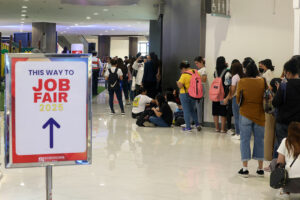Jobless rate drops to 2-month low

By Chloe Mari A. Hufana, Reporter
THE JOBLESS RATE slipped to a two-month low in February, as more Filipinos joined the labor force ahead of the summer season and midterm elections, the statistics agency said on Tuesday.
At the same time, the underemployment rate — an indicator of job quality — fell to a nine-month low of 10.1%.
Preliminary data from the Philippine Statistics Authority’s (PSA) Labor Force Survey (LFS) showed the jobless rate stood at 3.8%, easing from 4.3% in January.
Year on year, this was slightly higher than 3.5% a year ago.
This translated to 1.94 million jobless Filipinos in the second month of the year, lower than the 2.16 million seen in January 2025. Year on year, it was higher than the 1.8 million unemployed Filipinos seen in February 2024.
For the first two months of 2025, the jobless rate averaged 4%, same as a year ago.
“In February we’re already picking up an increase in employment, mainly due to political organizations hiring people, which is around 41,000. Most probably, this will continue until May, and that, in a way, creates seasonality,” PSA Undersecretary and National Statistician Claire Dennis S. Mapa told a news briefing in mixed English and Filipino.
In February, the employment rate rose to 96.2%, equivalent to 49.15 million, from 95.7% in January which translated to 48.49 million employed Filipinos.
Year on year, it was slightly lower than 96.5% in February 2024, which was equivalent to 48.95 million Filipinos with jobs.
Mr. Mapa noted election-related employment is not substantial compared with “core areas” such as the service sector and wholesale and retail trade, particularly food and accommodation.
The campaign period for the May 12 elections began in February.
At the same time, job quality improved in February as the underemployment rate slipped to 10.1% from 12.4% in the same month a year ago and 13.3% in January.
The ranks of underemployed Filipinos — those who want longer work hours or an additional job — fell to 4.96 million from 6.08 million a year ago and 6.47 million in January.
For the two-month period, underemployment averaged 11.7%, falling from 13% a year ago.
“What is substantial here is the visible underemployed, those working less than 40 hours, and those sectors that have seen a significant increase,” Mr. Mapa said.
Underemployment declined in several sectors such as wholesale and retail trade, transportation and storage, other service activities, and manufacturing.
 BIGGER LABOR FORCE
BIGGER LABOR FORCE
PSA data also showed 51.09 million Filipinos were part of the labor force in February, higher than the 50.65 million in January, and the 50.75 million in the same month last year.
The labor force participation rate (LFPR) — the proportion of the working-age population (15 years old and over) that is part of the total labor force — slipped to 64.5% in February from 64.8% a year ago. Month on month, the LFPR inched up from 63.9% in January.
“Notably, the country’s labor force participation increased by 345,000. The significant decline in participation among youth aged 15-24 reflects a growing trend of young individuals actively pursuing education, highlighting our National Government’s commitment to investing in the future of its youth,” Labor Secretary Bienvenido E. Laguesma told BusinessWorld in a Viber chat.
The youth LFPR slipped to 31.1% in February, down from 33.8% a year earlier and 31.8% in January 2025.
The youth employment rate stood at 89.6% in February, lower than the 91.4% posted a year ago.
In a separate statement, Mr. Laguesma said the February jobs data reflect the government’s “firm commitment as it maintains a positive outlook and encouraging trajectory for our labor market.”
The National Economic and Development Authority (NEDA) said the Philippines’ unemployment rate “remains comparable” to Malaysia (3.1%) and Vietnam (2.2%), and lower than China (5.4%) and India (6.4%).
“We will build on our momentum and intensify our efforts to secure strategic job-generating investments, promote a dynamic and innovative business environment, and diversify growth drivers,” NEDA Secretary Arsenio M. Balisacan said in a statement.
“The continued rollout and implementation of high-impact infrastructure flagship projects, particularly in energy, transport, and digital connectivity, will boost domestic employment and business activity,” he added.
Finance Secretary Ralph G. Recto said the strong labor market can help shield the Philippine economy from a looming trade war and global uncertainties.
“A strong and growing workforce means rising incomes, greater spending power, and sustained job creation. This fuels consumer demand and pushes our economy forward,” Mr. Recto said in a statement.
“We must continue to boost domestic demand, especially in these uncertain times marked by brewing trade wars. A strong and resilient domestic market is our best defense,” he added.
 Federation of Free Workers President Jose Sonny G. Matula said the improvement in the labor market can be attributed to a combination of economic recovery efforts and government programs.
Federation of Free Workers President Jose Sonny G. Matula said the improvement in the labor market can be attributed to a combination of economic recovery efforts and government programs.
“Post-pandemic recovery momentum has led to increased consumer activity and business reopening, especially in services and hospitality,” he said in a Viber chat.
He also noted the administration’s “Build Better More” infrastructure program continues to generate construction-related jobs, as well as boost mobility and tourism in key provinces.
Government cash-for-work programs and localized employment initiatives may have also contributed to the uptick in employment, Mr. Matula added.
University of the Philippines Diliman School of Labor and Industrial Relations Assistant Professor Benjamin B. Velasco welcomed the improvement in jobs but noted that quality is more important.
“Better employment figures shown in the LFS are welcome. But better quantity of jobs does not imply better quality of jobs,” he said in a Facebook Messenger chat.
By sector, services remained the top employer, accounting for 61.6% of total employed persons in February, followed by agriculture (20.1%) and industry (18.3%).
The accommodation and food service sector had the biggest annual employment gains in February, adding 377,000 jobs. This was followed by fishing and aquaculture (+365,000), public administration and defense (+330,000), construction (+258,000), and other service activities (+232,000).
Mr. Mapa noted there was an increase in employment in the accommodation and food service sector ahead of the summer season.
Month on month, wholesale and retail trade; repair of motor vehicles and motorcycles had the biggest jump in the number of employed persons at 620,000.
Mr. Mapa said the additional 620,000 were mostly employed in nonspecialized stores with food and beverages.
PSA data showed agriculture and forestry lost the most workers year on year, shedding almost 950,000 in February.
This was followed by administrative and support service activities (-201,000) and transportation and storage (-158,000).
“Whenever there are job losses, whatever the sector, it is a cause for concern,” Mr. Laguesma said.
The labor chief noted that in 2024, the country was hit with several devastating typhoons and weather disturbances that affected agriculture and forestry.
“The country is calamity-prone which mainly contributes to our losses in the agriculture and fishery sectors. Hopefully, we don’t experience the same this year,” Mr. Laguesma said.
Month on month, agriculture and forestry lost the most workers (-520,000), followed by administrative and support service activities (-308,000), and transportation and storage (-176,000).
Mr. Laguesma said the government will continue its initiatives to boost employment, such as the upcoming Labor Day Job Fair.
The department is also bolstering its efforts to empower the youth through the JobStart Program, Special Program for Employment of Students, and Government Internship Program.
“To ensure this thrust, [we are] actively engaged in continuous capacity-building initiatives nationwide to strengthen the implementation of these youth employability programs through our Public Employment Service Offices and program implementers,” he added.
In a note, Chinabank Research said the Philippine labor market is expected to remain stable, but cited risks such as global uncertainties, higher US tariffs and a global slowdown.
“Looking ahead, the service sector will likely remain a key driver of job growth, supported by steady domestic demand. On the other hand, goods-producing sectors, especially those reliant on foreign demand, may face headwinds from higher tariffs from the Philippines’ biggest export market: the US. Nevertheless, opportunities remain through diversification and policy support,” Chinabank Research said.
Meanwhile, Mr. Balisacan said the government is set to launch the Trabaho Para sa Bayan Act Plan 2025-2034.
This includes programs to improve the competitiveness of the Filipino workforce, encourage innovation and promote technology adoption among enterprises, and enhance labor market governance.
For his part, Mr. Matula proposed a shift toward agro-industrialization as a long-term solution, especially in rural areas.
He noted the importance of investing in value-added industries within agriculture and fisheries — such as food processing, logistics, and export development — to generate more stable, higher-paying employment opportunities.
He also highlighted the need for stronger government support for micro, small, and medium enterprises.












